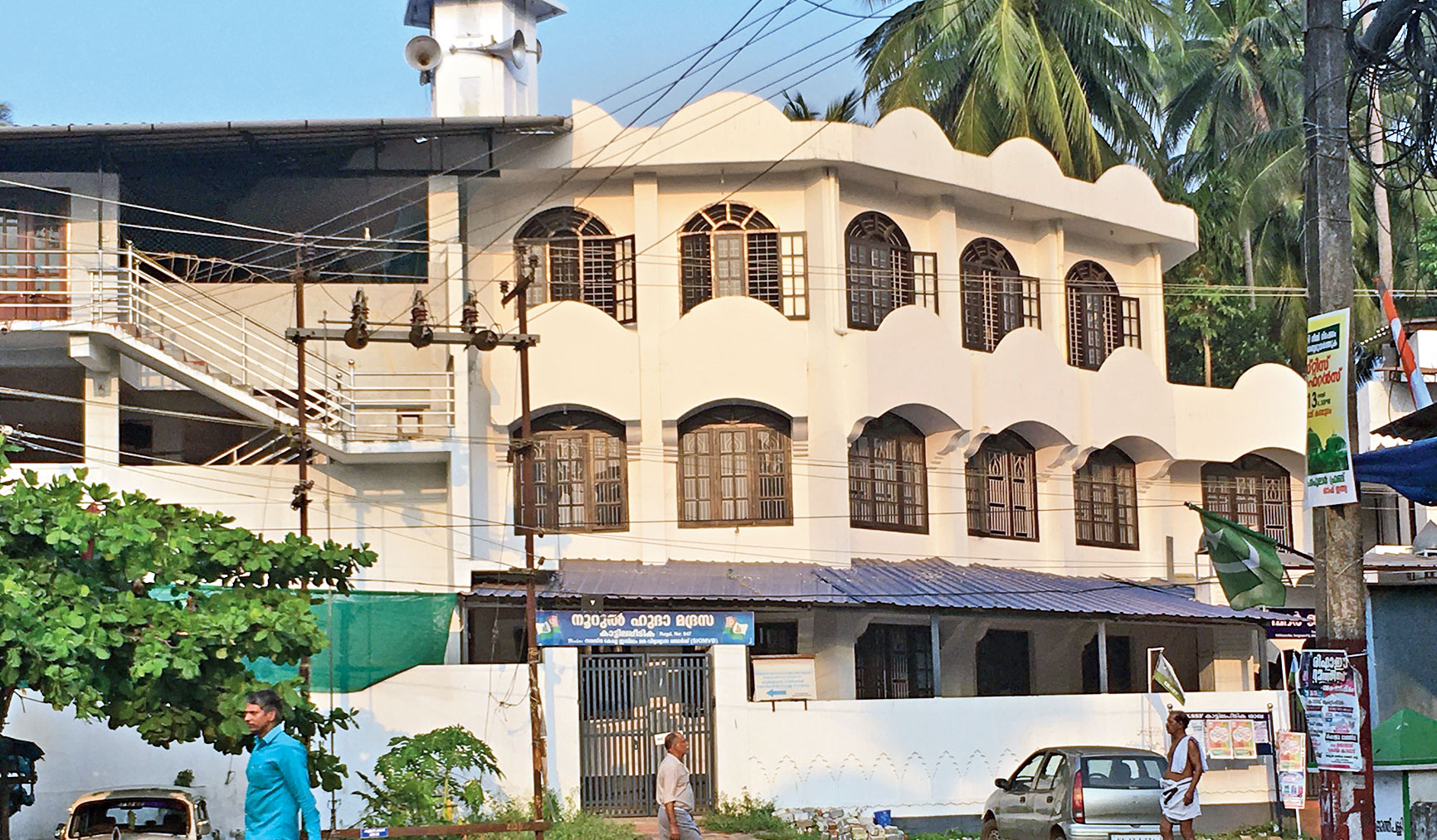Sometimes the chime of the temple bells forms a sort of accompaniment to the azan from the mosque.
“And sometimes, the temple stops playing holy songs during azan,” Haris PK, secretary of the mosque’s mahallu (neighbourhood) committee, told The Telegraph.
That’s how the Sree Hamsakulangara Meledathu Siva Temple and Badr Juma Mosque, which share a boundary wall, have been creating harmony for a half-century now in their corner of Kerala.
“Usually our morning and evening prayers don’t clash with the azan. But whenever needed, we have risen to the occasion to help them,” said U. Shivanandan, president of the temple governing committee.
Local people said the temple has been known even to halt the singing of bhajans by devotees for a while so that the azan is not disturbed.

The Sree Hamsakulangara Meledathu Siva Temple in Kattilapeedika in Kozhikode, Kerala (K.M. Rakesh)
Haris said the two shrines’ cheek-by-jowl existence off the busy Kozhikode-Kannur highway may surprise the travellers but not the residents of Kattilapeedika, the town 15km north of Kozhikode where they are located.
“This brotherhood is natural for both the Hindus and Muslims of this place since it’s a part of our life,” the textile businessman added.
One incident perhaps best illustrates how the common boundary wall has been a symbol of unity rather than separation.
It happened about a decade ago when a recent extension of the temple structure prevented hired elephants from going round the shrine — a key ritual during annual temple festivals in Kerala.
“One corner near the boundary wall had become too narrow for the elephants to pass through. So we approached the mosque committee for help, as we always do,” temple committee secretary Subhash Chandran said.
The mosque authorities were requested to move the boundary wall a little inwards on their side, with the temple offering to pay for the small slice of mosque land that would then fall on the temple’s side, freeing up space for the elephants.
“But the mosque committee gave us the land free of cost, handing the document over at a public event at the temple,” Chandran said.
Shivanandan said the centuries-old temple had been in ruins before it was renovated in 1962. At the time, an old prayer room “for (Muslim) travellers and bullock cart drivers” stood on the other side of the boundary wall.

The Badr Juma Mosque in Kattilapeedika in Kozhikode. (K.M. Rakesh)
“The mosque came up in the early 1970s at the site where the prayer room existed,” he said.
There has never been a single note of discord.
“We invite each other (clerics, priests as well as community members) to all the religious festivals at the temple and the mosque. Both communities make sure that we attend all the events and have whatever food is served there,” Shivanandan said.
Chandran described how the mosque and the local Muslim community had repeatedly helped the temple with money and goods.
“We are restoring an ancient temple pond and had sought donations to fund the project. Our Muslim brothers have individually donated sums ranging from a few thousand to as much as Rs 2 lakh,” he said.
“Whenever we inform them about any temple event or festival, they donate money and offer whatever support is necessary.”
Such help has come even during Muslim religious events.
“Last Ramazan, an individual donor had given a large number of kits (bags of goodies) containing rice, food grains and edible oil to the mosque. They were meant for poor Muslims. But the mosque committee wanted to share it with us,” Chandran said.
The temple distributed the bags of goodies donated by the mosque among poor Hindus.
Both communities are, however, aware of the ever-growing religious polarisation in the country.
“Our main fear now is that media coverage would put us in some kind of corner. Usually some or other mischief-maker pokes their nose in when things are good,” Shivanandan said.
Temple committee vice-president Sujith Kumar and Haris, however, are confident that no matter what kind of pressure is exerted, harmony would prevail.
“We won’t budge an inch from our commitment to brotherhood,” Kumar said. “Haris goes to the mosque to pray while I go to the temple; that will continue unhindered. Right-wing elements from either side can say what they want; we don’t care.”










